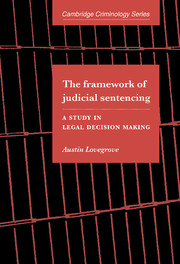Book contents
- Frontmatter
- Contents
- List of figures
- List of tables
- Acknowledgments
- 1 Judicial decision making and sentencing policy: continuation of a study
- 2 A sentencing decision model: single and multiple similar counts
- 3 A sentencing decision model: multiple disparate counts
- 4 Testing the decision model for multiple disparate counts
- 5 The techniques of data collection
- 6 Judges' thoughts on sentencing the multiple offender
- 7 An alternative sentencing decision model for the multiple offender
- 8 Validity and development of the alternative decision model: the data collection
- 9 Towards a requisite decision model for sentencing the multiple offender
- 10 The armature of judicial sentencing
- Appendix 1 Case 37 from Sentencing Research Exercise – Part 3B
- References
- Index
10 - The armature of judicial sentencing
Published online by Cambridge University Press: 22 August 2009
- Frontmatter
- Contents
- List of figures
- List of tables
- Acknowledgments
- 1 Judicial decision making and sentencing policy: continuation of a study
- 2 A sentencing decision model: single and multiple similar counts
- 3 A sentencing decision model: multiple disparate counts
- 4 Testing the decision model for multiple disparate counts
- 5 The techniques of data collection
- 6 Judges' thoughts on sentencing the multiple offender
- 7 An alternative sentencing decision model for the multiple offender
- 8 Validity and development of the alternative decision model: the data collection
- 9 Towards a requisite decision model for sentencing the multiple offender
- 10 The armature of judicial sentencing
- Appendix 1 Case 37 from Sentencing Research Exercise – Part 3B
- References
- Index
Summary
To this point in the current study two quite conceptually distinct decision models of sentencing in cases comprising multiple counts, properly regarded as separate transactions, have been proposed: one model applies where all the offences belong to the same legal offence category and the other covers circumstances where at least two of the offences belong to different statutory offence categories. The task of this chapter is to integrate these two models in order to complete the decision framework underpinning the judicial determination of sentence, and to consider how this decision structure is to play its role as a numerical guideline.
Now, the decision model for multiple offences of the same type cannot be applied to the problem of determining the effective sentence for a case comprising separate types of offence, since the parameters of this model are defined in terms specific to a particular type of offence and treat the series of offences globally (see Chapter 3). So, for example, the measure of organization as an offence factor is not aggregated across each of the counts but is measured in terms of what is the characteristic level for that series of offences; now, clearly, this definition cannot be applied where the comprising offences belong to different offence categories, since the way in which organization is manifest varies with the type of offence.
- Type
- Chapter
- Information
- The Framework of Judicial SentencingA Study in Legal Decision Making, pp. 250 - 263Publisher: Cambridge University PressPrint publication year: 1997



